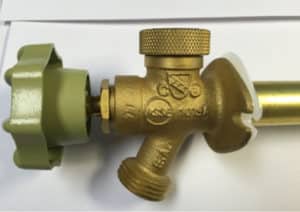Frequently Asked Questions
You’ve got questions, we’ve got answers! Watch this video or refer to the drop tabs below for easy answers to some of the most frequently asked questions. Still want to know more? Give us a call at 844-493-7641.
A cross-connection is an actual or potential connection between the safe drinking water (potable) supply and a source of contamination or pollution. State plumbing codes require approved backflow prevention methods to be installed at every point of potable water connection and use. Cross-Connections must be properly protected or eliminated.
HydroCorp has been contracted to assist with the Cross-Connection Control (CCC) Program. The CCC program includes two parts: On-site inspections and testing of existing backflow prevention assemblies. The HydroCorp inspector will be conducting a visual inspection of the water uses both inside and outside of your home (spigots, lawn irrigation system, utility sinks, boilers, etc.) to identify cross connections that could possibly contaminate your drinking water or the public water supply.
Hose Connection Vacuum Breaker
Residential Cross-Connection Control Survey | Exterior from HydroCorp on Vimeo.
Most CCC programs began with inspections of all the commercial and industrial accounts. As a natural progression of this program we are now inspecting residential water customers.
All water customers (residential and nonresidential) connected to the public water supply are required to be inspected for cross connections. Due to the total number of homes that shall be inspected, not all inspections can be completed in 1 year. The program is a multi-year program where all homes will receive the first inspection in any year during the duration of the program.
An average inspection normally takes from 10 to 20 minutes, depending on the size of your home/property.
Yes - if you received a letter informing you to call or go online and arrange for an appointment, someone over 18 must be home to allow our inspector to enter the home and complete the inspection.
Yes. We just need a name and number so that the inspector can contact you to set up a time that is convenient for you.
If you are the owner of the home being inspected, you are responsible for any needed repairs. Renters may have to refer to their lease agreements in order to determine whether they are responsible for repairs.
All HydroCorp inspectors wear photo ID badges during inspections and are prepared to provide appropriate documentation verifying their identities.

Yes. These inspections are conducted in order to ensure compliance with state regulations to maintain the safety of your drinking water.
Penalties for refusing to cooperate with inspections and/or refusing to make needed repairs are determined by your local water utility. These typically can include termination of water service, a fine, or both.
The anti-siphon fill valve device is located in the tank of your toilet. This device has a dual purpose: To fill the toilet and prevent backflow. This device must be placed at the proper height in order to insure that water from your toilet does not backflow into your drinking water. Proper placement is typically done during the installation process but can be easily overlooked. This device must be raised or the overflow pipe must be cut down in order to achieve a 1” air gap separation between the “critical level” of the assembly.
Click here to see an installation diagram.
Click here for 3 minute video overview.
Residential Cross-Connection Control Survey | Exterior from HydroCorp on Vimeo.
Example: Hose connection vacuum breakers |
Example: Integrated vacuum breaker on outside hose spigot. |
Example: Hose end in bucket |
Example: Hose end in pool |
 |
Vacuum breaker should not be subject to continuous pressure like the example here illustrates. (This type of irrigation set up/system would need to be corrected.) |
 Pressure Vacuum Breaker Assembly |
 Reduced Pressure Principle Backflow Prevention Assembly |

5700 Crooks Road, Suite 100 • Troy, MI 48098 • 844-493-7641




